Most of us have gotten loyalty cards at one point or another that treated us to a free item after a certain amount of purchases at that particular establishment. Most of us have also tossed more than one of those cards after realizing they weren’t worth the space in our wallets for the amount of time it would take to reach this requisite amount. Stores continue to keep loyalty cards because allowing customers to monitor progress toward their free item goal motivates them to achieve that goal. However, the way that many of them frame goal progress may actually be counterproductive. Similarly, the way we frame progress toward our own goals may be setting us back.
A recent paper in the Journal of Consumer Research investigates how the way in which we visualize progress toward a goal affects goal adherence. They frame their proposal as the “small-area hypothesis,” or the idea that we are more motivated by whichever portion of our goal—amount attained or amount remaining—is smaller. Therefore, directing individuals’ attention toward that smaller area will be effective in motivating them to achieve their goal.
The authors tested this idea through a series of four studies. In each, they presented participants with loyalty cards that focused either on how much of the goal had been achieved or how much remained. For instance, in the example shown, the coffee shop either stamped an image of a cup to represent progress achieved or punched out a cup stamp to show how much progress remained (i.e., how many cups were left).
Though each study had slightly different manipulations, the basic take-home point remained consistent. When far from their goal, customers were more likely to return if progress made was emphasized (as in the top coffee card), but that when close to their goal, customers were more likely to return if progress remaining was emphasized (as in the bottom coffee card). They interpret their empirical support for the “small-area hypothesis” to mean that focusing on the smaller area rather than the larger area is motivational because each action toward the goal has an inherently larger marginal impact. That is, acquiring your third stamp on the way to a 10-stamp card increases the ‘stamps attained’ (small-area) amount by 50 percent but decreases the ‘stamps remaining’ (large area) amount by only 12.5 percent.
By extension, the authors suggest, this strategy may be helpful in achieving personal goals as well. Trying to make it through an hour-long workout? You might try focusing on the minutes you’ve endured at the start and switching to the minutes remaining as you get closer to the end. What exactly to do in the middle remains unclear, but this preliminary set of studies nonetheless provides an important peak into the cognitive biases that can both motivate and demotivate us.
